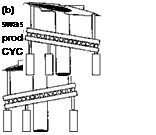Blade Feathering and the Swashplate
The blade pitch (or feathering) motion can be described as the Fourier series 9(r, ф) — #twr + Oq + 9c cos ф + 0s sin ф
![]() H—– + One cos пф + 0ns sin пф + • • •,
H—– + One cos пф + 0ns sin пф + • • •,
where r is the nondimensional radial position on the blade. Blade-pitch motion comes from two sources, namely
1. Commanded input from the helicopter control system. This is done by means of a swashplate, the orientation of which is controlled by the pilot. The control inputs produced by the swashplate consist of the collective pitch Bo and the first harmonics of the Fourier series: the lateral cyclic Bic and the longitudinal cyclic Bs. The collective pitch controls the average blade pitch angle and, therefore, the blade lift and average total rotor thrust. The cyclic pitch controls the orientation or tilt of the rotor disk and so the direction of the rotor thrust vector.
2. Elastic deformations (twist) of the blade and control system. The elastic (torsional) deformations of the blade, and although small, they are significant. However, these can be neglected at the present level of analysis.
The swashplate is the key to effecting pitch control to the rotor blades, for which a photo is shown in Fig. 4.10 and a schematic in Fig. 4.11. The swashplate has rotating and nonrotating disks concentric with the rotor shaft. A set of bearings between the two disks allows the upper disk to rotate with the rotor while the lower is nonrotating. Both disks can be slid up and down the shaft in response to collective inputs and the swashplate can also be tilted to an arbitrary orientation in response to cyclic inputs from the pilot’s controls. A minimum of three pushrods or actuators are required to position the swashplate relative to the rotor shaft, which is connected (either mechanically or hydraulically) to the flight control system. The upper swashplate has a set of lugs that are connected to the blades, with one lug for each blade. The blade pitch motion itself is induced about a pitch or feathering bearing. A pitch horn is attached to the blade outboard of the pitch bearing. A pitch link is attached to the pitch horn and the upper (rotating) part of the swashplate in such a way that as the upper plate rotates, the vertical displacement of the pitch link produces blade pitch motion. The novel part of the helicopter swashplate is the ability to tilt the plate to an arbitrary orientation, which requires a gimbal or spherical bearing between the swashplate and the rotor shaft. This allows a first harmonic blade-pitch input with any phase angle. The earliest swashplate mechanisms for helicopter applications are documented in patents by Crocco in 1906, Yurev in 1910, and Hafner in 1922. See Prouty & Curtiss (2003) for a good review of other helicopter rotor control systems, including the swashplate.
 |
As shown in Fig. 4.12, the vertical motion of the swashplate results in a vertical motion of the pitch link and a collective pitch change to the blades. This either increases or decreases the rotor thrust. The fore and aft tilt of the swashplate translates into a once-per-revolution cyclic pitch on each rotor blade. This produces a once-per-revolution aerodynamic forcing, which causes the rotor blades to flap and the rotor to precess to a new orientation in space, thereby tilting the thrust vector. The system is really fundamentally very simple; an aerodynamic forcing is applied at or close to the natural frequency of the flapping blade and the blades respond so that a unit of cyclic pitch input results in (almost) a unit of flapping response.
 |
 |
|
(a) Vertical movement of swashplate
introduces COLLECTIVE pitch.
Figure 4.12 The movements of the swashplate result in changes in blade pitch, (a) Collective pitch, (b) Cyclic pitch.
Notice that for a centrally hinged rotor system, the term 9c controls the lateral orientation of the rotor disk and 9s controls the longitudinal orientation. Remember that for a rotor with a centrally located flapping hinge there is an exact 90° force-displacement phase-lag. In the case of pure 9c (cosine) cyclic motion, the maximum applied aerodynamic force occurs at i/r = 0° and so the maximum flapping displacement occurs 90° later at = 90°. Therefore, the application of a 9c pitch displacement causes the rotor to tilt laterally to the left, which is equivalent to a f}s flapping motion and, therefore, this is called lateral cyclic. By a similar argument, the application of a 9s pitch displacement causes the disk to tilt back longitudinally, which is equivalent to a — f3c flapping displacement, and this is called longitudinal cyclic.
For a contrarotating coaxial rotor system, both rotors must be tilted. Therefore, the pitch angles of both sets of rotors must be connected together through two swashplates so that they tilt in unison. Figure 4.13 gives some idea of the mechanical complexity of the control linkages to do this. Nevertheless, the different aerodynamic environments found on both rotors results in considerable differential flapping. This requires significant spacing between the rotors to ensure that the blades do not collide. The much larger rotor mast and exposed rotor flight control linkages, therefore, result in a high parasitic drag in forward flight. This is one major disadvantage of the coaxial rotor configuration.











